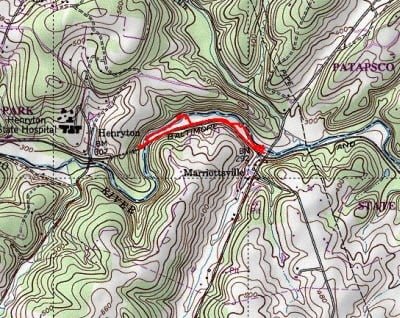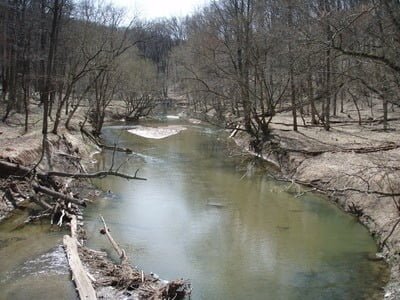After finishing Piney Run, I was curious about what the Patapsco would look like upstream from Marriottsville. Two years ago during the summer, I walked a mile and a half downstream and fished my way back up. At that point, I was looking for a smallmouth bass, but actually caught a holdover trout during the expedition. The downstream environment revealed a riverbed with a muddy, sandy bottom and high banks; hopefully the perspective upstream would be different. After pulling into the parking lot on this first day of fishing after the extended closure, I launched out on the well marked, beaten trail headed upstream. Prior to starting my quick walk, I looked around near the parking area and noted that there is a nice riffled area immediately under the bridge that leads upstream into a number of deep holes that, on this day, were surrounded by many other anglers plumbing the depths in search of the recently stocked trout.
After wishing them well, I moved rapidly upstream casting my “trained” fisherman’s eyeballs across the slow-moving river. Like downstream, the bottom was sandy with random, scarce boulders and minimalist rocky stretches interspersed between deeper pools. In general terms, every bend in the river features a deep hole and each was packed with fishermen. It was easy to solve the stocking truck calculus since there is a wide road that runs right next to the train tracks that permit the stock truck to move all the way up to the tunnel that punches through the high ridge separating this section from the Sykesville access point upstream.
About halfway up to the bridge, I hopped into the water and, given my success with nymphs on Piney Run earlier in the day, continued with that approach. I fished my way upstream for a couple hundred yards without sparking any interest at all. My luck could have been impacted by the fact that I focused on the runs between the holes since I did not want to belly up to the bar with all the other anglers. Clearly, they knew something that I did not. But, there should’ve been fish since there were deeper cuts in the shallow channels that generally hugged the northern bank of the river. After being unsuccessful, I got out and walked up to where the railroad tracks cut through the mountain. Immediately downstream of the railroad bridge, there’s a sharp bend in the river with rocky boulders and a cliff where the river cuts right to make a run towards the parking lot. Of course, there were three other fishermen already working it hard. I took a look upstream where the river moves away from the rail bed in a big loop to join the railroad tracks on the other side of the ridge – shallow and sandy. Given that, I decided to call it a day and go somewhere else.
Tell a friend about this article by clicking on this link

Patapsco River Trout Fishing Bottom Line: I am not a fan of this stretch of river. Given the sandy bottom, I wonder if the smallmouth get back up in here in any volume at all. I have heard from other people that there is better smallmouth water on the other side of the tunnel. Given that this was still early in the season and the smallmouth would be wherever they go when the water is cold, I did not go farther upstream to check that out – but it would be something to do in warmer weather. So, unless this section has been recently stocked with trout, it’s probably not worth the drive.
Date Fished: 3/27/2010
Getting There: The DNR site has good directions – From I-695, take exit to MD Rt 40 west or from I-70 take exit 83 to Marriottsville Road north. Follow the signs to the park. Once you cross the river, the parking area to go fishing is on the west side of the road.
Google Local Coordinates: 39.351722,-76.898997
Secrets Revealed? No. This is a very public location that is documented in the Maryland DNR stocking plan

Good path through a “park-like” shelf next to the river

Riffle area under the bridge near the parking lot

Typical stretch between pools

Deep pools at each bend

View upstream from the railroad bridge – sandy

Downstream from the bridge has marginally better water
Unless stated otherwise, this article was authored by Steve Moore


